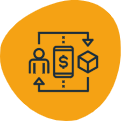
AccuracyUpwards of 95%
An unsure shopper may pick up multiple products and cart them around the shop before returning them to the display, but does that mean your merchandising has been successful in getting his/her attention? A naughty child may take her mother’s cart, wheel it all over the shop, and even add scores of items to the cart, but does that mean the mother was on a buying spree? In-store analytics, like any other technology, will have its limitations as shoppers may not always behave in straitjacketed and rational ways that we assume from them. All said and done, in-store analytics technology is only as good as the accuracy it can guarantee. We have seen that anything below 95% may not be worth your money and time.

Visitor Profiling Demographics and style preferences
Data is currency. Knowing how many pairs of feet walked into your store is one thing. And knowing who the person was is completely another. Your in-store analytics solution must help you identify your visitor like an old friend. It should tell you their gender, their age. It should give you a peek into their world, their style choices, their likes, and dislikes, and must help you personalize your promotions to them outside the store – in emails, Facebook feeds and in-app advertising. Besides helping you personalize and enhance in-store engagement, these additional data points can help you adopt upcoming trends like visual loyalty. In short, you should be able to know and understand your in-store shoppers equally well, if not better than your online shoppers.

Omenichannel View In the store, on the mobile and on the web
Accenture has found in its research that “60% of Gen Z shoppers prefer to purchase in stores,” and “46% will check in store to get more information before making an online purchase.” As evident, Gen Z shoppers do not see the retail store as distinctly separate from its eCommerce counterpart. They are merely using both for a cohesive shopping experience. Retailers will need to ensure this line of thinking extends to data and insights. Your in-store analytics solution must offer a 360-degree view of your shoppers. It should, for example, tell you if those who left empty-handed from the store purchased something from you later via eCommerce and vice versa.

Visual Dashbords Updating in real or near real-time
B2C sales are fast by their very nature. They are also seasonal and vulnerable to various market fluctuations. Say you are in the year’s most important sales season, and your in-store insights are updated only hourly; it is a handicap. Knowing every instant how your shoppers are behaving can help you take proactive steps in time before the peak sales hours fly past. Thus, real-time data presented to you in the form of simple but meaningful visuals can help you prepare your shop and your staff much better.

Privacy ComplianceBased on opt-ins and permissions
While every brand would like the idea of being able to shadow their customers and prospective shoppers 24x7 across channels and locations, it raises many questions around consumer privacy and data safety. The last thing you want is to be on the wrong side of the law. Hence, you must choose an analytics solution that helps you adhere to the stringent and transparent privacy policy while aligning with an opt-in based data gathering and marketing strategy.

User DelightFor the shoppers as well as the staff
Since an in-store analytics solution works in a busy atmosphere, one with lots of the hustle and bustle, it needs to withstand and facilitate the way shoppers and staff behave in the shop. Data gathering should not irk shoppers or embarrass the staff. New ways of shopping or checking out must not become bad surprises for new walk-ins, and overall, the users must be empowered rather than impeded by the presence of technology.
Faster Deliveries6
An intelligent order management system can foresee bottlenecks in delivery according to real-time conditions, and reroute the delivery onto the fastest route. Additionally, an OMS offers flexibility with delivery. Based on the clients requirements, the order can intelligently be split into multiple shipments based on costs or delivery location. In comparison to a traditional delivery system, using an OMS automatically provides the inventory personnel detailed information on the delivery at hand, leaves less room for human error, saves time and streamlines the entire process.





